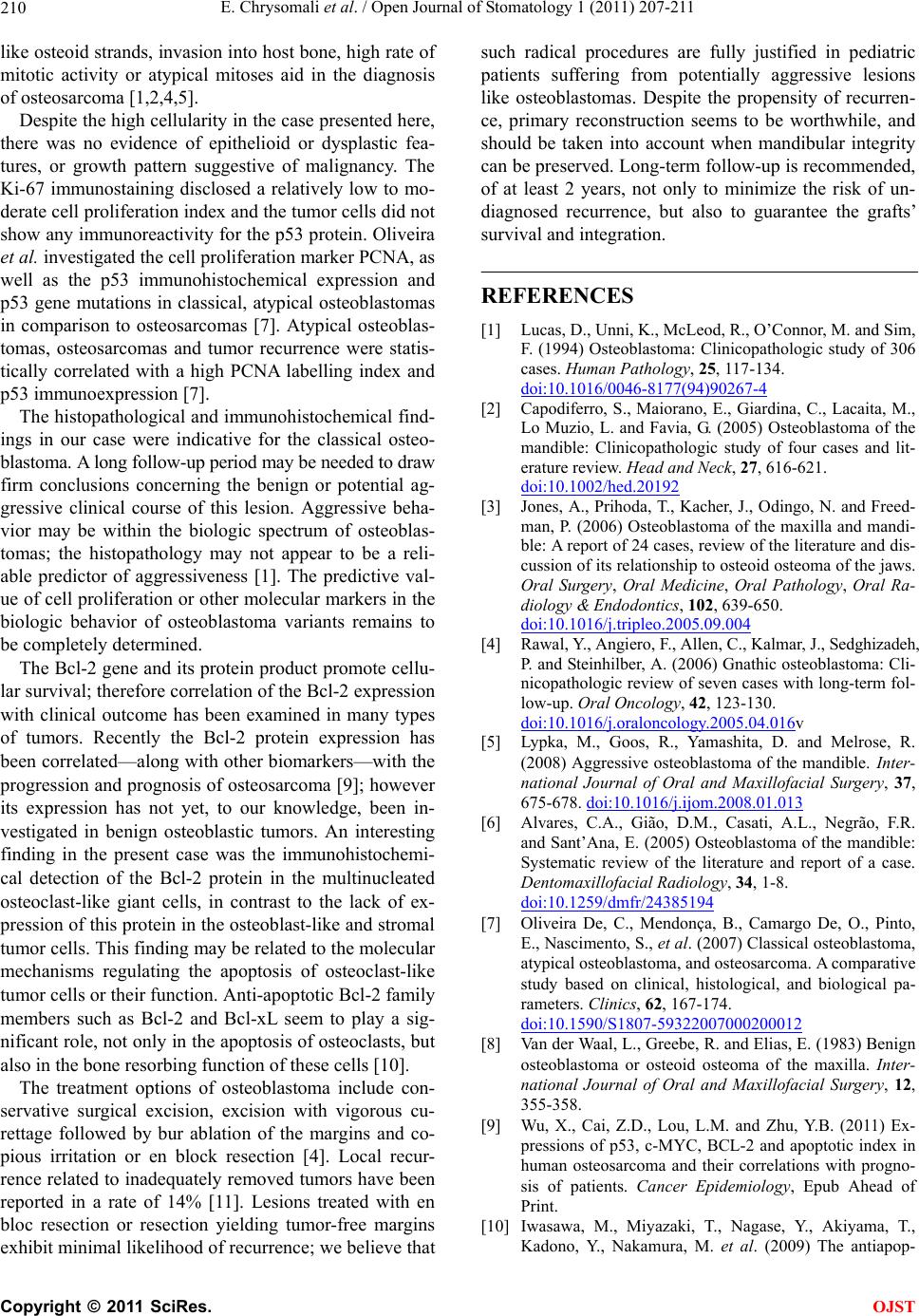
E. Chrysomali et al. / Open Journal of Stomatology 1 (2011) 207-211
210
like osteoid strands, invasion into host bone, high rate of
mitotic activity or atypical mitoses aid in the diagnosis
of osteosarcoma [1,2,4,5].
Despite the high cellularity in th e case presented here,
there was no evidence of epithelioid or dysplastic fea-
tures, or growth pattern suggestive of malignancy. The
Ki-67 immunostaining disclosed a relatively low to mo-
derate cell proliferation index and th e tumor cells did not
show any immunoreactivity fo r the p53 protein. Oliveira
et al. investigated the cell proliferation marker PCNA, as
well as the p53 immunohistochemical expression and
p53 gene mutations in classical, atypical osteoblastomas
in comparison to osteosarcomas [7]. Atypical osteoblas-
tomas, osteosarcomas and tumor recurrence were statis-
tically correlated with a high PCNA labelling index and
p53 immunoexpression [7].
The histopathological and immunohistochemical find-
ings in our case were indicative for the classical osteo-
blastoma. A long follow-up period may be needed to draw
firm conclusions concerning the benign or potential ag-
gressive clinical course of this lesion. Aggressive beha-
vior may be within the biologic spectrum of osteoblas-
tomas; the histopathology may not appear to be a reli-
able predictor of aggressiveness [1]. The predictive val-
ue of cell proliferation or other molecular markers in the
biologic behavior of osteoblastoma variants remains to
be completely determined.
The Bcl-2 gene and its protein product promote cellu-
lar survival; therefore correlation of the Bcl-2 expression
with clinical outcome has been examined in many types
of tumors. Recently the Bcl-2 protein expression has
been correlated—along with other biomarkers—with the
progression and prognosis of osteosarcoma [9]; however
its expression has not yet, to our knowledge, been in-
vestigated in benign osteoblastic tumors. An interesting
finding in the present case was the immunohistochemi-
cal detection of the Bcl-2 protein in the multinucleated
osteoclast-like giant cells, in contrast to the lack of ex-
pression of this protein in the osteoblast-like and stro mal
tumor cells. This finding may be related to the molecular
mechanisms regulating the apoptosis of osteoclast-like
tumor cells or their function. Anti-apoptotic Bcl-2 family
members such as Bcl-2 and Bcl-xL seem to play a sig-
nificant role, not only in the apoptosis of osteoclasts, but
also in the bone resorbing function of these cells [10].
The treatment options of osteoblastoma include con-
servative surgical excision, excision with vigorous cu-
rettage followed by bur ablation of the margins and co-
pious irritation or en block resection [4]. Local recur-
rence related to inadequately removed tumors have been
reported in a rate of 14% [11]. Lesions treated with en
bloc resection or resection yielding tumor-free margins
exhibit minimal likelihood of recurrence; we believe that
such radical procedures are fully justified in pediatric
patients suffering from potentially aggressive lesions
like osteoblastomas. Despite the propensity of recurren-
ce, primary reconstruction seems to be worthwhile, and
should be taken into account when mandibular integrity
can be preserved. Long-term follow-up is recommended,
of at least 2 years, not only to minimize the risk of un-
diagnosed recurrence, but also to guarantee the grafts’
survival and integ ration.
REFERENCES
[1] Lucas, D., Unni, K., McLeod, R., O’Connor, M. and Sim,
F. (1994) Osteoblastoma: Clinicopathologic study of 306
cases. Human Pathology, 25, 117-134.
doi:10.1016/0046-8177(94)90267-4
[2] Capodiferro, S., Maiorano, E., Giardina, C., Lacaita, M.,
Lo Muzio, L. and Favia, G. (2005) Osteoblastoma of the
mandible: Clinicopathologic study of four cases and lit-
erature review. Head and Neck, 27, 616-621.
doi:10.1002/hed.20192
[3] Jones, A., Prihoda, T., Kacher, J., Odingo, N. and Freed-
man, P. (2006) Osteoblastoma of the maxilla and mandi-
ble: A report of 24 cases, review of the literature and dis-
cussion of its relationship to osteoid osteoma of the jaws.
Oral Surgery, Oral Medicine, Oral Pathology, Oral Ra-
diology & Endodontics, 102, 639-650.
doi:10.1016/j.tripleo.2005.09.004
[4] Rawal, Y., Angiero, F., Allen, C., Kalmar, J., Sedghizadeh,
P. and Steinhilber, A. (2006) Gnathic osteoblastoma: Cli-
nicopathologic review of seven cases with long-term fol-
low-up. Oral Oncology, 42, 123-130.
doi:10.1016/j.oraloncology. 2005.04.016v
[5] Lypka, M., Goos, R., Yamashita, D. and Melrose, R.
(2008) Aggressive osteoblastoma of the mandible. Inter-
national Journal of Oral and Maxillofacial Surgery, 37,
675-678. doi:10.1016/j.ijom.2008.01.013
[6] Alvares, C.A., Gião, D.M., Casati, A.L., Negrão, F.R.
and Sant’Ana, E. (2005) Osteoblastoma of the mandible:
Systematic review of the literature and report of a case.
Dentomaxillofacial Radiology, 34, 1-8.
doi:10.1259/dmfr/24385194
[7] Oliveira De, C., Mendonça, B., Camargo De, O., Pinto,
E., Nascimento, S., et al. (2007) Classical osteoblastoma,
atypical osteoblastoma, and osteosarcoma. A comparative
study based on clinical, histological, and biological pa-
rameters. Clinics, 62, 167-174.
doi:10.1590/S1807-59322007000200012
[8] Van der Waal, L., Greebe, R. and Elias, E. (1983) Benign
osteoblastoma or osteoid osteoma of the maxilla. Inter-
national Journal of Oral and Maxillofacial Surgery, 12,
355-358.
[9] Wu, X., Cai, Z.D., Lou, L.M. and Zhu, Y.B. (2011) Ex-
pressions of p53, c-MYC, BCL-2 and apoptotic index in
human osteosarcoma and their correlations with progno-
sis of patients. Cancer Epidemiology, Epub Ahead of
Print.
[10] Iwasawa, M., Miyazaki, T., Nagase, Y., Akiyama, T.,
Kadono, Y., Nakamura, M. et al. (2009) The antiapop-
C
opyright © 2011 SciRes. OJST